When Laura Ward was born at 2:54 a.m. on September 11, 2016, she was, by all accounts, a beautiful, healthy baby.
“Everything went really well,” says Sarah, her mother. “She came out crying, and all her tests were normal.”
A few hours after her birth, a nurse came to check on Laura. At nine pounds 12 ounces, she was a large baby. As the nurse noted, larger babies often have low blood sugar, so it wasn’t a surprise when Laura’s test came back low. She was given formula, but her levels didn’t improve, even after a second and third feeding—the first sign that something might be off. When further tests revealed that Laura’s oxygen levels were also low, she was taken to the neonatal intensive care unit (NICU).
Still hopeful that the problem was nothing serious, Sarah and her husband, AJ, were waiting for results with Laura in the NICU, when a pediatric cardiologist came to see them.
“As soon as I heard his specialty my heart sank,” Sarah remembers. “Why did my perfect little girl need a cardiologist?”
The news he delivered was both the worst and the best they could have imagined.
“There’s something wrong with Laura’s heart,” he told them, “but we can fix it.”
Shocked
“Other than the usual sickness, I had the perfect pregnancy,” Sarah says. The couple found out they were expecting on New Year’s Eve, and their excitement only grew as Sarah’s due date approached.
They left their home in Saskatoon on September 10, expecting to be at the hospital for a couple of days; in the end, they were away for more than five months.
“When we heard the diagnosis, I was shocked,” says AJ. “Having a child born with a heart condition was not something that had ever occurred to me as being a possibility.”
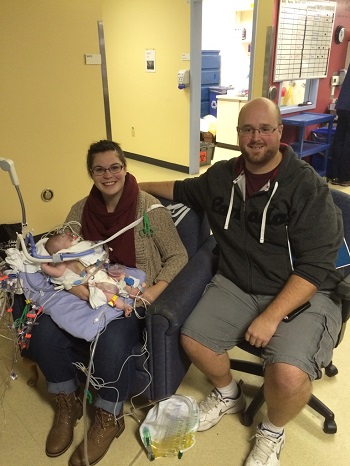 Sarah, AJ and Laura, shortly before her fourth open-heart surgery
Sarah, AJ and Laura, shortly before her fourth open-heart surgery
“It’s one of the only heart conditions that can be cured,” Sarah says. “So there was a lot of hope. We thought, If something had to be wrong, this isn’t the worst thing, and we held on to that.”
Out of Operation
Two days after Laura’s birth, the family travelled to Edmonton, where the surgery would be performed—Sarah and Laura by medical plane, AJ and Sarah’s mother, Major Lee Anne Hoeft, by car. Sarah’s father, Major Mike Hoeft, followed soon after.
With little time to prepare for their stay in an unfamiliar city, they were grateful for the practical assistance they received from family, friends and The Salvation Army.
“We were fortunate to be able to stay in an apartment that belongs to the Army,” says Sarah, a senior soldier at Saskatoon Temple. “That was helpful because there’s nothing in place for families in our situation. You have to pay for a hotel, or hope to get into a Ronald McDonald House, but their waiting list is huge.”
When it was time for the surgery, Sarah and AJ walked with Laura to the operating room. “That was so tough,” Sarah remembers. “When you watch the doors to the surgical suite close, all you feel is emptiness and fear.”
Six and a half hours later, the surgery appeared to be a success. There were some complications—a collapsed lung meant Laura required respiratory support—“but her recovery was going well otherwise,” Sarah shares. “Her heart looked good so we thought we were in the clear.
“But nine days after her surgery, very unexpectedly, her heart stopped.”
The Darkest Hours
Laura was in cardiac arrest for 90 minutes. “They tried everything and nothing was working,” Sarah says. “They just couldn’t get her back. No explanation—they had no idea what happened.”
With Laura’s life hanging in the balance, the family took time to pray.
“My dad prayed with us and it meant so much,” Sarah remembers. “He also sent out a call for prayer to the other pastors in the Prairie Division.”
The only option was to put Laura on full life support—an extracorporeal membrane oxygenation (ECMO) machine. After the ECMO was set up, Sarah and AJ were invited to see Laura.
“There are no words to describe the sight we saw when we walked in,” Sarah remembers. “She was attached to more wires, lines and tubes than you could count. But somehow, it was still Laura.”
“In the darkest times, God was there to get us through. No matter how sick Laura got, I always felt like he was watching over her.”
In the days that followed, Laura had numerous procedures—but as one problem was fixed, another would take its place. About a month after her birth, when Laura was facing yet another open-heart surgery, the weight of the situation nearly overwhelmed AJ.
“Sarah and I were incredibly nervous about this surgery because it had a 25 per cent mortality rate,” he says. “This was the first time that we started to think there was a possibility that Laura might not make it.
“Yet it helped knowing that my parents and hundreds of people, spread out across the whole continent, were praying for Laura,” he continues. “We were scared, but we were together and could lean on each other for support.”
As before, Laura’s health improved after surgery. But on November 14, at just two months old, she experienced her second and third cardiac arrests, lasting seven and 30 minutes each.
“The worst part was being told, ‘We don’t know if she’s still there,’ ” Sarah says. “ ‘After this much damage, and this much time without oxygen to her brain, we don’t know what she’ll be like when she wakes up.’ ”
While they waited for Laura to be put on ECMO again, Sarah and AJ had their most difficult conversation yet. “We had to ask, at what point do we say enough is enough?” Sarah remembers. “But we both said, ‘Let’s fight until there’s no reason to.’ ”
“In the darkest times, God was there to get us through,” adds AJ. “No matter how sick Laura got, I always felt like he was watching over her.”
Life Support
After the second and third cardiac arrests, it became clear that Laura needed a heart transplant. “The doctor told us, ‘If she’s well enough to get a transplant, that’s our only option,’ ” Sarah shares. “So all of a sudden, transplant went from this big scary word, to the only thing that was hopeful.”
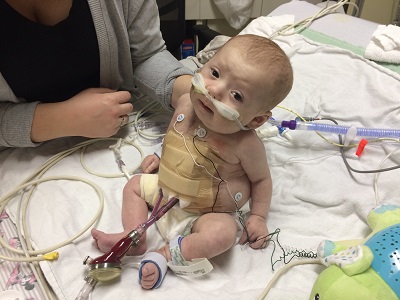 While waiting for a transplant, Laura was given an external mechanical heart
While waiting for a transplant, Laura was given an external mechanical heart
By the time Christmas came, Laura was learning to sit up—awkward though it was with the Berlin heart attached to her—and her breathing tube was removed. “After three months, we were finally able to hear her voice,” Sarah remembers with a smile.
The Wards spent Christmas in the hospital’s intensive care unit, but made the best of it—setting up a small Christmas tree and exchanging gifts. “At that point, it was nice to be in the ICU for Christmas,” Sarah says. “We had lived with the people there for three months, so they were our family.”
Sarah and AJ expected Laura to be on the transplant list for three to six months. But after just 54 days, they received the news: a new heart was available.
“I think that was the happiest moment I’ve ever experienced,” says AJ.
The Best Gift
On January 7, 2017, Laura had her sixth and final open-heart surgery. “She had been through so many more complicated surgeries at that point, that getting a heart transplant kind of seemed like nothing,” Sarah says with a laugh. “It sounds funny, but we were really relaxed for her transplant surgery.”
The Wards spent five weeks in the hospital in Edmonton post-operation, before they were transferred to Saskatoon and then, finally, home.
“We had prepared for a newborn and, instead, we were going home with a five-month-old, so nothing was ready,” Sarah smiles. “Before we left, we didn’t even know if we were having a boy or a girl!”
Of course, Laura was no ordinary baby girl. When Sarah and AJ first brought her home, she was on a feeding tube and required feedings every three hours. She was also on 14 medications, which she received every two hours, day and night, as well as two daily injections.
“We knew it was a lot to take on, but we were so ready to leave the hospital,” says Sarah. “We had to be her medical team at home, as well as her parents, and it was hard. But we dealt with it gladly because we had Laura at home with us and that was the best gift we could have received.”
Dedication
Within a few months, Laura’s health improved to the point where she no longer needed a feeding tube and she was down to just four medications and two supplements. With physical and occupational therapy, Laura was even on track developmentally for her age.
When Mother’s Day came in May, it was a day of celebration—not only because Laura had come so far, but also because it was the day Sarah and AJ had Laura dedicated at their corps, with Majors Mike and Lee Anne leading the service.
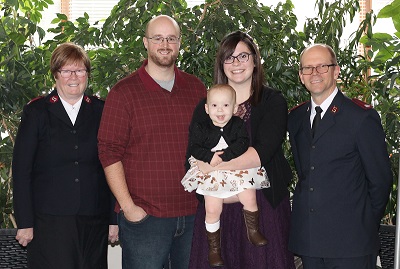 AJ, Sarah and Laura, with Sarah’s parents, Mjrs Lee Anne and Mike Hoeft, at their home corps, Saskatoon Temple. Mjrs Hoeft hold social services appointments in Saskatoon, with Mjr Mike also serving as area commander in the Prairie Div (Photo: Sarah Williams)
AJ, Sarah and Laura, with Sarah’s parents, Mjrs Lee Anne and Mike Hoeft, at their home corps, Saskatoon Temple. Mjrs Hoeft hold social services appointments in Saskatoon, with Mjr Mike also serving as area commander in the Prairie Div (Photo: Sarah Williams)
The service was deeply meaningful for the corps family as well.
“Our corps in Saskatoon was incredibly supportive,” says AJ. “They prayed for Laura and for us constantly. They also assisted us financially through a fundraising dinner and love offerings, which were hugely helpful.”
“It was a big deal for them to see Laura looking as good as she did,” Sarah adds. “They were able to see that their prayers had been answered.”
Gratitude
Now 18 months old, Laura is walking, talking and growing, just like any other happy toddler.
“She smiled for the first time before her third open-heart surgery, when she was only a month old, and she never stopped smiling,” says Sarah.
Still, as a transplant recipient, Laura faces unique challenges. To avoid rejection, she takes immunosuppressant medications, which increase her vulnerability to illness. So when Laura picked up a cold over the Christmas holidays, it meant several trips to the clinic, blood tests, medication adjustments and around-the-clock care.
But despite the difficulties they’ve faced, Sarah and AJ approach their transplanted life with gratitude and faith.
“We thank God all the time, even in the absolute worst times,” Sarah says, “because we got to see Laura pull through. We got to see all of these miracles happen in her life. The whole experience has really strengthened our faith.
“If ever I were to doubt that God is with us, I just have to look at Laura,” she concludes. “It’s a clear sign, right in front of me, that he’s been with us, and he always will be.”
Read more about Laura, Sarah and AJ on Sarah's blog, Our Transplanted Life.




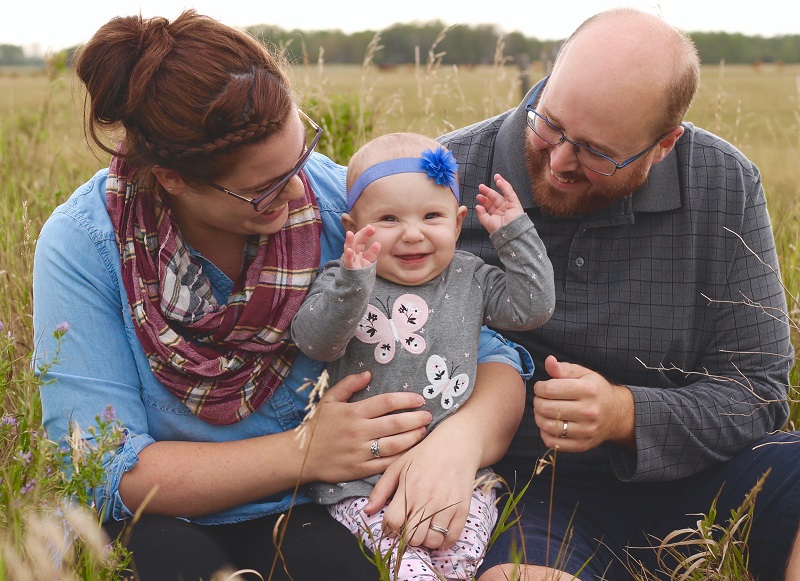

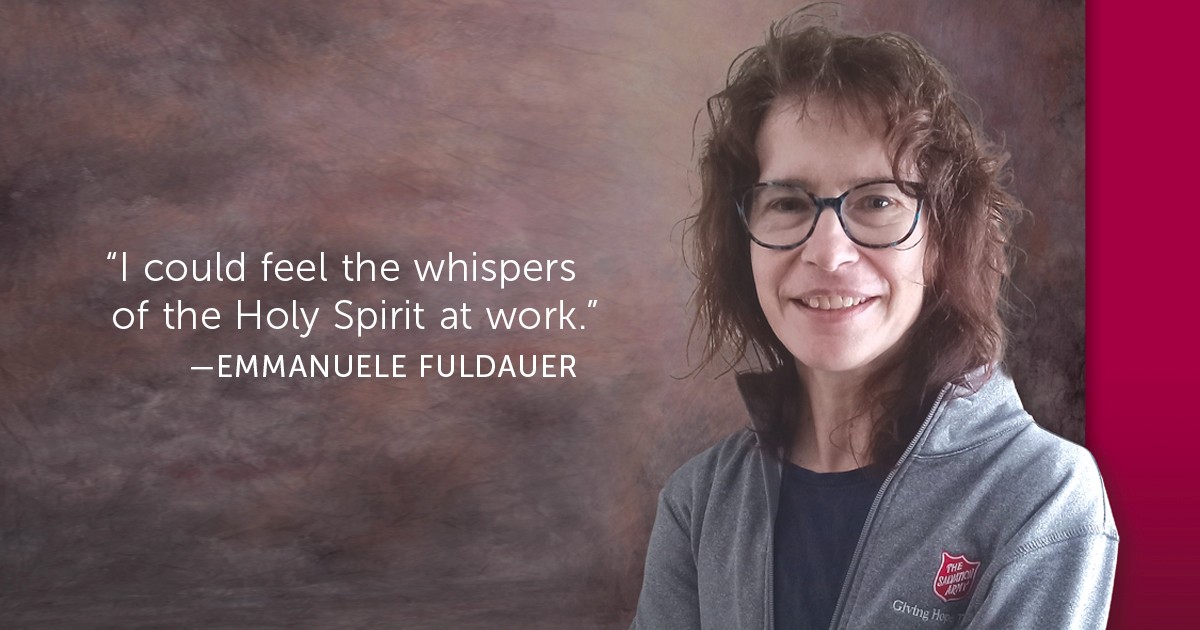



Comment
On Friday, April 6, 2018, Donald Ward said:
On Monday, March 19, 2018, Lorna Rogers said:
Leave a Comment